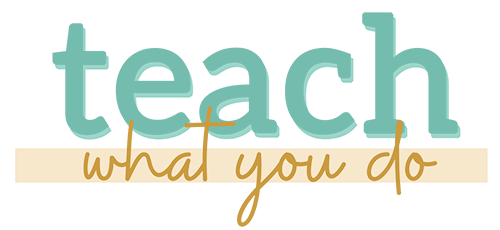
A key challenge when teaching is to give your students a path to making their own original works that aren't simply replications of your own projects.
You need to do more than present a project that gets copied.
You need to facilitate your students' own development–as artists or strategists or decision makers.
If you're teaching acrylic painting or copywriting or graphic design or business strategy, the desired outcome is going to vary for each student and their own projects.
The process for teaching a student to get to their own outcome is going to rely on you deconstructing your own creative process.
STEP 1. Break down the elements of your process.
Ask yourself first what are the PARTS or INGREDIENTS of the work you're teaching.
What goes into the work you're teaching?
For example: If you're teaching parents how to get a baby to nap, you've got:
- the baby and
- the baby's personality,
- you've got the baby's physical condition at the moment, you've got the baby's surroundings,
- you've got the parental attitudes.
Those are the parts of the work.
Another example: If you're teaching graphic design and making a poster the parts include:
- the message you need to convey,
- the imagery you'll use
- the words you'll include, and
- the space within which they'll be arranged.
Next break down more aspects of your process:
- the tools you use
- your go-to models
- techniques
- rules and principles you rely on
STEP 2. Identify steps in your process and the decision-making “crossroads”
Now identify how your student gets from where they are to where they want to be: the steps.
As you do this, also identify CROSSROADS along that path. These are the points where your students need to make a decision.
For example: Extending our poster design example above, the student needs to decide:
- Which images to use
- Which words to include
- How the images and text will be rendered in size, color, and proportions
- Which fonts to use
- How elements will be placed in relationship to one another
- How the space will be used–and even left empty–on the poster
STEP 3. Give your students rules they can lean on to make “crossroads” decisions.
With the process and all the pieces broken out, now you'll need to develop a model in which you show students how to behave at a crossroads: how to make decisions so that their outcome is uniquely theirs.
Which rules and principles will help them? What can your students can turn to as they move through this process making it their own?
For example: With the poster design example, you'll teach your student key graphic design principles–like, emphasis, contrast, and alignments–and how to use them to get particular effects.
You'll give your students a route they can rely on to place all these pieces in way that produces a solid and appealing design.
RECAP
To teach creative topics, deconstruct your own process in order to make lessons that get students their own original outcomes:
- STEP 1. Break down the elements of your process.
- STEP 2. Identify steps in your process and the decision-making “crossroads.”
- STEP 3. Give your students rules they can lean on to make “crossroads” decisions.
